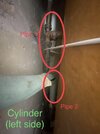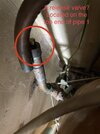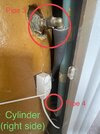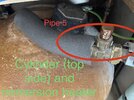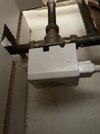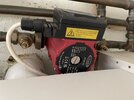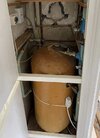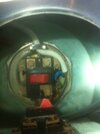As a first step I'd check that there is not a thermostatic mixing valve in the feed to the shower. If so, this may well be set to limit the temperature to around 40 degrees, and it won't get any hotter at the outlet.
You are using an out of date browser. It may not display this or other websites correctly.
You should upgrade or use an alternative browser.
You should upgrade or use an alternative browser.
Improving HW Temperature (Regular Boiler, Vented Gravity-fed System)
- Thread starter gabx
- Start date
Sponsored Links
The boiler did not seem to cycle on and off frequently during the 1.5 hours.So after say 1.5 hrs the cylinder stat is reaching 60C, if so and if the whole say effective 110L was heated from 25C to 60C then the cylinder coil is emitting < 2.0kw, something very wrong there, was the boiler cycling on and off very frequently?.
Check the cylinder coil return (bottom) pipe and see if it has a valve on it, either a wheel valve or a valve with a lever on it.
I identified five pipes that go into the cylinder. I took some photos of the cylinder to show the current set up.
Pipe 1 and pipe 3 are warm to the touch. Pipe 3 enters the cylinder at a slightly higher position than pipe 1. Am I correct to say pipe 1 is the coil return pipe? I can't find any wheel valve near pipe 1 but there is a turn knob (a release?) at the top end of pipe 1 above a T junction.
Pipe 2 and pipe 4 feel cold.
Pipe 5 is the hot water exit that connects to the taps if i am not mistaken.
Thanks
Attachments
I believe the current setup is a Y plan. the boiler is located on ground level inside a kitchen cabinet. i can find a pump right above the boiler and there is a 3 port valve to the side if i am not mistaken.Is any heat reaching the other radiators? If the 3-port valve is old and worn out, this can happen.
I don't know the limits of the heat exchanger coil in a yellow cylinder. If it was only 3kW, it would take about 2 hours to heat 120 litres. There might also be sludge in the pipes. There will be losses from poor insulation. Presumably it is fully pumped? Please show some photos of the pipes, cables and devices around the cylinder.
Have a look in the loft and see if the feed and expansion tank is hot.
P.s.
Buy some thermometers so you can accurately test the water.
the radiators in the house run reasonably.
will try to check the loft later in the day.
Attachments
Please clarify what you mean by this ambiguous statement....the radiator inside my bathroom is connected to DHW instead of CH.
I'm sure that you don't mean the hot water from the cylinder discharges via this radiator!!
Does this radiator get hot when only CH is demanded?
It is quite popular to run a bathroom radiator in 'summer' configuration so that it gets hot when either CH or HW or both are demanded. If this is the case make sure the lockshield valve on the bathroom radiator is shut down sufficiently to cause a significant (~15C) drop in temperature between the in and out pipes. If this rad is flowing too much it will lower the boiler output and divert heat away from cylinder heating.
You may conclude that you need to heat the cylinder for longer to get its contents up to 60C, however this only needs to happen once per week to control legionnella and, if you have a 7 day timer then you could continue with your 'cool' regime except for one day per week when you heat to a full 60C.
As indicated in other posts, you can't waste money on insulation...an extra jacket, or even an old duvet will give benefit.
Sponsored Links
yes, i mean the bathroom radiator gets hot when i switch on DHW. the same radiator does not get hot when I switch on CH but i will check again to be sure.Please clarify what you mean by this ambiguous statement.
I'm sure that you don't mean the hot water from the cylinder discharges via this radiator!!
Does this radiator get hot when only CH is demanded?
It is quite popular to run a bathroom radiator in 'summer' configuration so that it gets hot when either CH or HW or both are demanded. If this is the case make sure the lockshield valve on the bathroom radiator is shut down sufficiently to cause a significant (~15C) drop in temperature between the in and out pipes. If this rad is flowing too much it will lower the boiler output and divert heat away from cylinder heating.
You may conclude that you need to heat the cylinder for longer to get its contents up to 60C, however this only needs to happen once per week to control legionnella and, if you have a 7 day timer then you could continue with your 'cool' regime except for one day per week when you heat to a full 60C.
As indicated in other posts, you can't waste money on insulation...an extra jacket, or even an old duvet will give benefit.
will follow your advice regarding weekly cylinder heating and insulation. thanks!
first thing in the morning i set the cylinder thermostat to 60C and let the boiler ran DHW on for a full hour (with CH switched off and boiler's Auto function on). after an hour, my boiler was still running at 70C and the cylinder thermostat did not seem to have kicked in.
water coming out from the tap was hotter than before (my gut feel was maybe 10C hotter) after an hour of boiler operation.
I then continued to run DHW on for another half an hour to see if the thermostat would kick in. After another 20 minutes the boiler finally stopped running.
Considering the cylinder was not emptied the night before, is 1 hour and 20 minutes of reheating time indicative of any problem in my system? I start wondering if my cylinder/boiler/insulation is too inefficient for DHW.
From personal experience, with a couple of cylinders of that age, I don't think 1 hour 20 minutes is out of the ordinary to reach 60C with a flow of 70C.
What is the T piece circuled in Pipe 1 photo?, is it a valve connecting pipe 3 (coil inlet) to the pipe return which should be near the bottom of the cylinder.The boiler did not seem to cycle on and off frequently during the 1.5 hours.
I identified five pipes that go into the cylinder. I took some photos of the cylinder to show the current set up.
Pipe 1 and pipe 3 are warm to the touch. Pipe 3 enters the cylinder at a slightly higher position than pipe 1. Am I correct to say pipe 1 is the coil return pipe? I can't find any wheel valve near pipe 1 but there is a turn knob (a release?) at the top end of pipe 1 above a T junction.
Pipe 2 and pipe 4 feel cold.
Pipe 5 is the hot water exit that connects to the taps if i am not mistaken.
Thanks
In your image 6044 it looks as if the cylinder stat is resting on the insulation. It should he touching the copper cylinder. This is done by cutting a rectangular piece out of the insulation to fit the thermostat. Use a round-ended table knife, not a pointed knife that might puncture the copper ( it is a soft metal, and very thin).
will try to check the loft later in the day.
See what colour is the mud in the feed and expansion tank, and how deep it is. Try not to stir it up.
Here is a picture showing the entire cylinder.Stand back and take a pic showing the entire cylinder and all its pipes, cables and accessories please
Shall attend to this. Thanks for pointing out.In your image 6044 it looks as if the cylinder stat is resting on the insulation. It should he touching the copper cylinder. This is done by cutting a rectangular piece out of the insulation to fit the thermostat. Use a round-ended table knife, not a pointed knife that might puncture the copper ( it is a soft metal, and very thin).
Attachments
Here is my twin coil cylinder, with solar coil in the bottom and the oil fired heating coil heating the top 100 litres, its still performing the same but I have very soft water (no scaling), that cylinder replaced a 1972, 120L one in 2011after 39 years, the electric dual immersion elements were like new so I transferred it into this present cylinder, this immersion is now 53 years old with the sink/bath c/o switch on the top of the immersion!!. luckily I only use the sik element.From personal experience, with a couple of cylinders of that age, I don't think 1 hour 20 minutes is out of the ordinary to reach 60C with a flow of 70C.
Attachments
DIYnot Local
Staff member
If you need to find a tradesperson to get your job done, please try our local search below, or if you are doing it yourself you can find suppliers local to you.
Select the supplier or trade you require, enter your location to begin your search.
Please select a service and enter a location to continue...
Are you a trade or supplier? You can create your listing free at DIYnot Local
Sponsored Links
Similar threads
- Replies
- 26
- Views
- 2K
- Replies
- 23
- Views
- 5K
M
- Replies
- 2
- Views
- 1K


